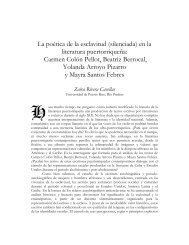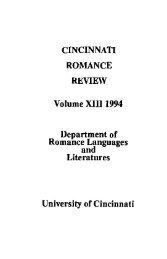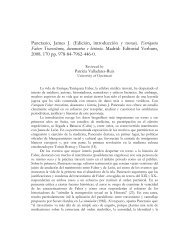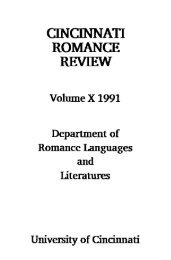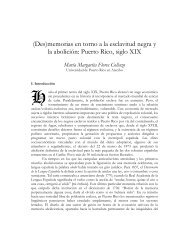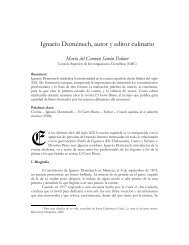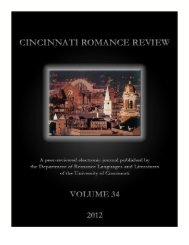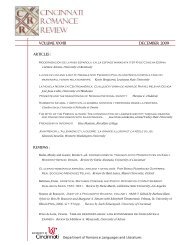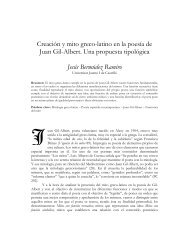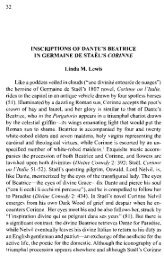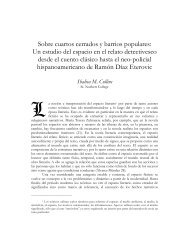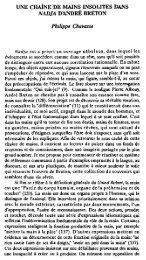Volume 30 (2011) - Cincinnati Romance Review
Volume 30 (2011) - Cincinnati Romance Review
Volume 30 (2011) - Cincinnati Romance Review
You also want an ePaper? Increase the reach of your titles
YUMPU automatically turns print PDFs into web optimized ePapers that Google loves.
“DOUBLE CONSCIOUSNESS/DOUBLE BIND” 79<br />
of color worked more manual labor jobs as servants, cooks, and bedside nurses than<br />
white women (Jiménez Muñoz 86).<br />
Not all of Colón Pellot’s poetry praises white women at the expense of the<br />
mulata. Similar to de Burgos’s “Ay, ay, ay,” other poems by Colón Pellot evoke the<br />
theme of mestizaje or more specifically mulatez. In Ian Smart’s seminal text Nicolás<br />
Guillén: Popular Poet of the Caribbean, he defined mulatez as the “harmonious aesthetic<br />
union of the opposing elements”, that is, the African and European heritage elucidated<br />
in Guillén’s well known poem “Balada de los dos abuelos” (164). Despite the historical<br />
conflict of conquest and slavery that characterized his essence, Guillén found a way to<br />
reconcile his African and Spanish heritage poetically and aesthetically through mulatez.<br />
Stylistically and thematically Colón Pellot’s poem “Canto a la raza mulata” echoes<br />
Guillén’s “Balada de los dos abuelos”. In his attempt to reconcile his two disparate<br />
heritages, Guillén humanizes both grandfathers by detailing their encounter in Africa<br />
and their subsequent poetic embrace. Despite the fact that one is the conquistador and<br />
slave master and the other is his slave, Guillén recreates a symbolic encounter and<br />
embrace that most likely never occurred historically. The last verses of his poem point<br />
to the union of Taita Facundo (the black grandfather) and Don Federico (the white<br />
grandfather), and the subsequent reconciliation of his mulato heritage:<br />
¡Federico!<br />
¡Facundo! Los dos se abrazan.<br />
Los dos suspiran. Los dos<br />
las fuertes cabezas alzan;<br />
los dos del mismo tamaño,<br />
bajo las estrellas altas;<br />
los dos del mismo tamaño,<br />
ansia negra y ansia blanca,<br />
los dos del mismo tamaño,<br />
gritan, sueñan, lloran, cantan.<br />
Sueñan, lloran, cantan.<br />
Lloran, cantan.<br />
¡Cantan! (56)<br />
The two grandfathers symbolically embrace erasing any cultural or racial<br />
differences. The grandfathers unite, amalgamate, and become equalized in stature.<br />
Similar to “Balada”, “Canto a la raza mulata” traces Colón Pellot’s African and<br />
European heritage and illustrates how “los conquistadores de la raza hispana y los<br />
siervos negros dieron vida a mi raza mulata” (22). Similar to “Balada,” the poem ends<br />
by extolling mestizaje racial:<br />
¡Es la raza mulata ambiciosa<br />
<strong>Cincinnati</strong> <strong>Romance</strong> <strong>Review</strong> <strong>30</strong> (Winter <strong>2011</strong>): 69-82.



